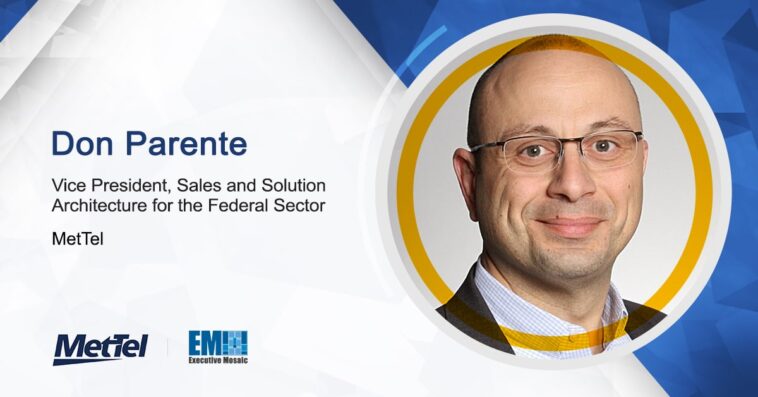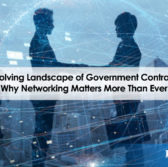Artificial intelligence and satellite innovations are driving advancements within the communications industry, and we’re just beginning to see how far these technologies can take us. In an Executive Spotlight with Executive Mosaic, MetTel Vice President of Public Sector Sales and Solution Architecture Don Parente spoke about how low earth orbit satellites, global networks and AI tools can help close the digital divide for government agencies.
Read below for Don Parente’s full Executive Spotlight interview.
Let’s start with space. What are our biggest opportunities in space, and how are we harnessing those opportunities to maintain our space superiority, especially during this era of increasing competition?
The market has an insatiable appetite for bandwidth and connectivity. All agencies have missions that benefit from better connectivity and broader footprints. The United States is leading the world with the build-out of proliferating, low earth orbiting satellite constellations like Starlink. Services like this allow agencies to execute their mission everywhere and anywhere. So, a worker sitting in a remote desert can have the same experience as someone working from an office building, but this is not where this story ends.
I think of networks as a platform. Much of the world’s greatest innovations have been built on this platform. Satellite communication is no different, it’s a platform. We will use this new platform to make ourselves more effective and more competitive in the world. It will be interesting to see how important this is going to be for our economy and government. In fact, we are hosting a special event (Space Age Communications Event (mettel.net) Feb. 7 in Washington in concert with Starlink and VMware to show the unlimited potential of delivering broadband from space for government. The GSA, Federal Mobility Group and system integrator SAIC will be joining us. It’s just the beginning of a major shift in how communications will be delivered.
Tell me about the current state of the artificial intelligence market. Where are you seeing new opportunities in AI, and where do you think the market is heading?

With artificial intelligence I think we’re really just getting started. I think of artificial intelligence as the next great productivity tool, much like the pivot from slide rules to scientific calculators or shifting from teams of mathematicians to using computer simulation tools. AI is going to allow us to do things quicker and be more productive than ever before.
So, what is the state of the market for AI? I think we’re just getting started. The art of the possible hasn’t been fully defined yet but ultimately, once we start applying these tools, things that took a long time in the past will get completed quicker. Thus, allowing us to focus our energies in other areas, higher value areas. For example, MetTel’s AI — Intelligent Process Automation — reviews all potential incidents in our network and remediates most of them on its own, freeing up our Network Services teams to focus on proactive work or only the most complex situations. Gartner has cited our AI app as best among the Leaders of the Gartner Magic Quadrant for Managed Network Services the past 4 consecutive years.
And there are whole new classes of jobs it is creating, with roles emerging now such as: AI data privacy manager, AI urban planner, AI cybersecurity manager, AI augmentation specialist, AI customer experience specialist, senior asset owner — generative AI, data science analyst, among others. You have to look at AI not as something that eliminates jobs but simply creates a shift in the workforce and the overall economy. I’m sure when the light bulb was invented everyone asked, ‘What are we going to do with all these candle makers.’ Ultimately those candle makers probably found work in other places, and perhaps some upskilled as electricians. So as much as AI is going to eliminate some mundane work for some, it will ultimately drive higher skill work for others.
In addition to AI, which other emerging technologies do you anticipate will have the greatest impact on the federal landscape in the next few years?
I’ll circle back to the first question regarding space. The proliferation of low earth orbit satellites is going to be a game changer for the government and quite frankly all of society. Think about the extended reach you get from these services, the ubiquity of coverage and — what’s really fascinating — the delivery of satellite cover and very low latency. This is unlike the higher orbiting satellites we always associate with space communications. These are systems that provide latency numbers that we would historically see in a terrestrial network. So, think about the impact of bandwidth and latency that looks like a wireline network, delivered from satellite. Now, all of a sudden, you’re closing the digital divide, you’re allowing government agencies to expand the footprint and reach of their mission, and enabling agencies to serve their constituents in ways they could not before. This is truly a game-changing technology
With all of these trends in mind, where are you seeing opportunities for expansion in MetTel’s portfolio? What new capabilities or markets are you eyeing?
These opportunities that seem futuristic are here now. Because MetTel is always on the leading edge of technology, we’re already rolling these capabilities into our portfolio. We’ve been implementing AI in our network management solution and it’s driving efficiencies already. We identify issues in the network before they become an issue, and we resolve troubles much quicker than ever before without requiring human intervention. This is leading to a reduction in downtime and an improvement in meantime to repair. We’re bringing low orbit satellite communications into our portfolio. We were the first in the market to bring SD-Wan over Starlink and, as a result, we’re helping our government customers reach locations they never thought were possible.





